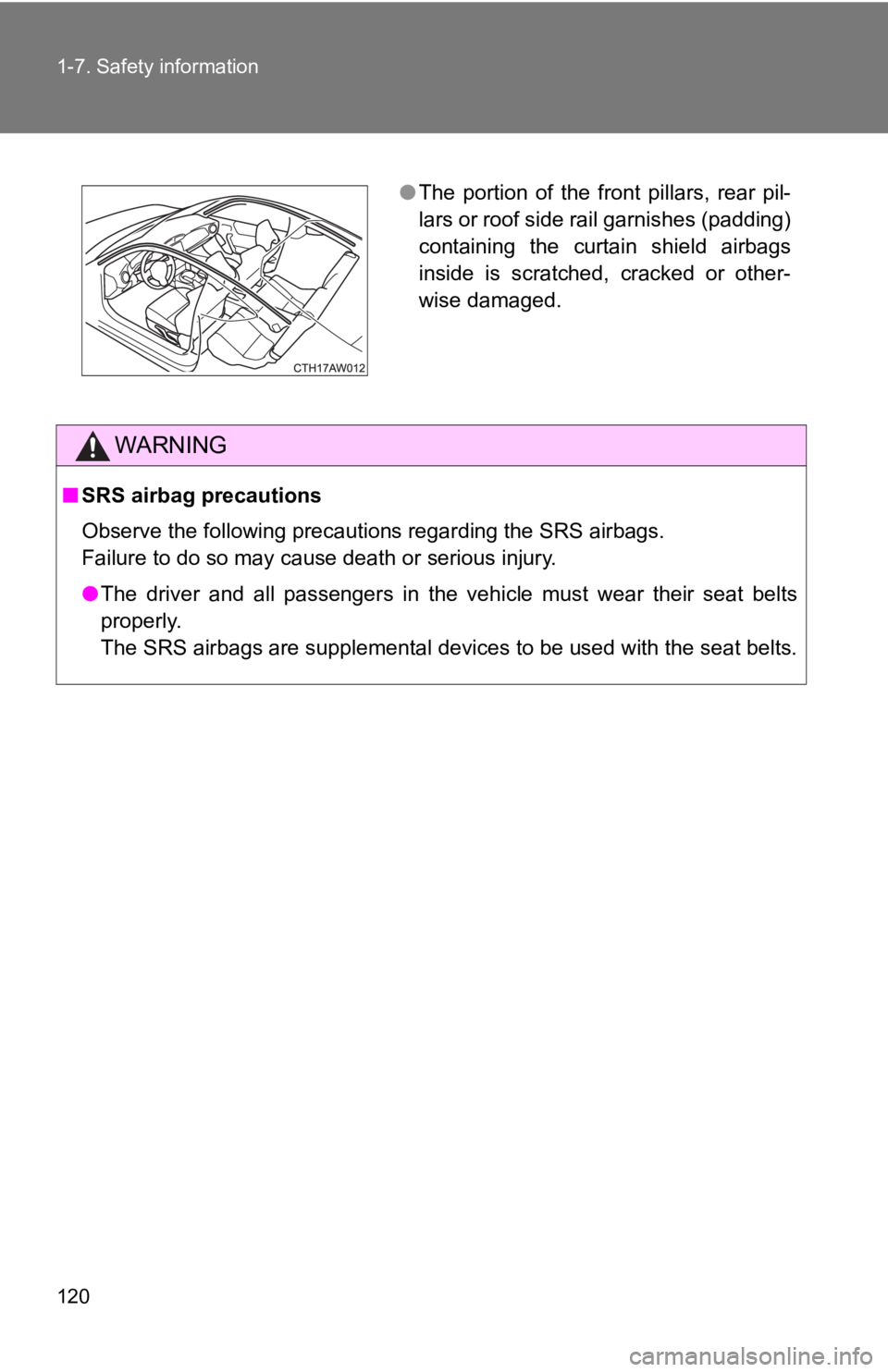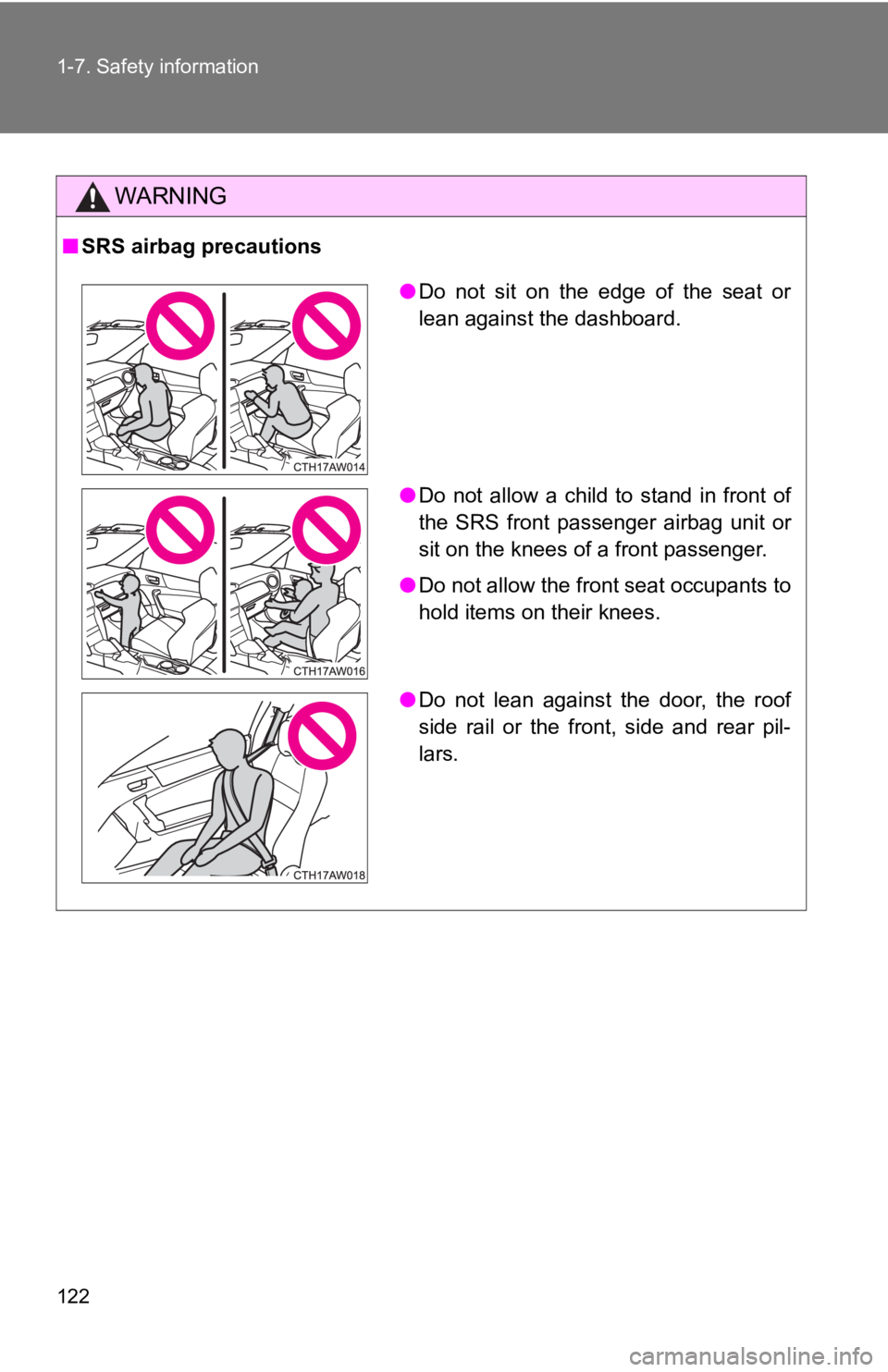2019 TOYOTA 86 warning
[x] Cancel search: warningPage 97 of 532

971-7. Safety information
1
Before driving ■ Driver’s SRS frontal airbag
The driver’s SRS frontal airbag uses a dual stage inflator. The inflator oper-
ates in different ways depending on the severity of impact.
Have the system inspected by your Toyota dealer immediately if the SRS
warning light illuminates.
NOTE
The driver’s SRS side airbag and SRS curtain shield airbag are not con-
trolled by the Toyota advanced frontal airbag system.
■ Front passenger’s SRS frontal airbag
The front passenger’s SRS frontal airbag uses a dual stage infl ator. The
inflator operates in different ways depending on the severity of impact.
The occupant classification system sensor is installed under th e seat uphol-
stery and monitors the physique and posture of the front passen ger. Using
this information, the occupant classification system determines whether the
front passenger’s SRS frontal airbag should be deployed or not.
The occupant classification system may not inflate the front passenger’s
SRS frontal airbag even when the driver’s SRS frontal airbag de ploys. This
is normal. In this case, although the front passenger’s SRS fro ntal airbag
does not operate, the front passenger’s seat belt pretensioner operates with
the driver’s seat belt pretensioner. For details about the seat belt preten-
sioner, refer to “Seat belt pretensioners”. ( P. 61)
Observe the following precautions. Failure to do so may prevent the Toyota
advanced frontal airbag system from functioning correctly or ca use the sys-
tem to fail.
● Do not apply any strong impact to the front passenger’s seat.
● Do not spill liquid on the front passenger’s seat. If liquid is spilled, wipe it
off immediately.
● Do not remove or disassemble the front passenger’s seat.
● Do not install any accessory (such as an audio amplifier) other than a
genuine Toyota accessory under the front passenger’s seat.
● Do not place anything (shoes, umbrella, etc.) under the front p assenger’s
seat.
● Do not place a magnet near the seat belt buckle.
Page 98 of 532

981-7. Safety information
If the seat belt buckle switch and/or front passenger’s occupan t classification
system have failed, the SRS warning light will illuminate. Have the system
inspected by your Toyota dealer immediately if the SRS warning light illumi-
nates.
If your vehicle has sustained impact, this may affect the proper function of
the Toyota advanced frontal airbag system. Have your vehicle in spected at
your Toyota dealer. Do not use the front passenger’s seat while driving the
vehicle to your Toyota dealer.
NOTE
The front passenger’s SRS side airbag and SRS curtain shield ai rbag are
not controlled by the Toyota advanced frontal airbag system.
■ Passenger’s frontal airba g ON and OFF indicators
P. 128
■ Occupant classification system
The occupant classification system sensor is installed under th e seat uphol-
stery and monitors the physique and posture of the front passen ger. Using
this information, the occupant classification system determines whether the
front passenger’s SRS frontal airbag should be deployed or not.
If the front passenger’s seat cushion is wet, this may adversel y affect the
ability of the system to determine deployment. If the seat cush ion is wet, the
front passenger should stop sitting on the front passenger’s se at. Wipe off
liquid from the seat immediately, let the seat dry naturally an d then check the
SRS warning light as follows.
● If the SRS warning light illuminates, keep the seat dry until t he warning
light turns off. If the SRS warning light stays on even when th e seat has
dried, do not allow anyone to sit on the front passenger’s seat and have
the system checked by your Toyota dealer.
● If the SRS warning light does not illuminate, check that the fr ont passen-
ger’s frontal airbag ON and OFF indicators work properly. If th e indicators
do not work properly, do not allow anyone to sit on the front p assenger’s
seat and have the system checked by your Toyota dealer.
Page 99 of 532

991-7. Safety information
1
Before driving Also, if luggage or electronic devices are placed on the front passenger’s
seat, this may adversely affect the ability of the system to de termine deploy-
ment. This may prevent the front passenger’s frontal airbag ON and OFF
indicators from working properly. Check that the indicators wor k properly.
When the OFF indicator turns off and the ON indicator illuminat es, the front
passenger’s frontal airbag may deploy during a collision. Remov e luggage
and electronic devices from the front passenger’s seat.
NOTE
This device complies with Part 18 of the FCC Rules. This device may cause
interference. If this device causes interference, consult the n earest Toyota
dealer. Also, for maintenance of the system, consult the neares t Toyota
dealer.
■ Conditions in which front passen ger’s SRS frontal airbag is not acti-
vated
The front passenger’s SRS frontal airbag will not be activated when any of
the following conditions are met regarding the front passenger’s seat:
● The seat is empty.
● The seat is equipped with an appropriate child restraint system and an
infant is restrained in it.
● The occupant changed their posture after the occupant load is j udged.
● The front passenger’s occupant classification system is malfunctioning.
WARNING
When the front passenger’s seat is occupied by an infant in an appropriate
child restraint system, observe the following precautions. Fail ure to do so may
interfere with the proper operation of the occupant classification system, acti-
vating the front passenger’s SRS frontal airbag even though tha t seat is occu-
pied by the infant in the child restraint system.
● Do not place any article (including electronic devices) on the seat other than
the infant in the child restraint system.
● Do not place more than one infant in the child restraint system .
Page 109 of 532

1091-7. Safety information
1
Before driving WARNING■ If the SRS airbags deploy
Do not touch the SRS airbag system components around the steeri ng wheel
and dashboard with bare hands right after deployment. Doing so can cause
burns because the components can be very hot as a result of dep loyment.
■ Child restraint precautions
NEVER INSTALL A REARWARD FACING CHILD SEAT IN THE FRONT
PASSENGER’S SEAT EVEN IF THE FRONT PASSENGER’S SRS FRON-
TAL AIRBAG IS DEACTIVATED. Be sure to install it in the REAR se at in a
correct manner. Also, it is strongly recommended that any forwa rd facing
child seat or booster seat be installed in the REAR seat, and t hat even chil-
dren who have outgrown a child restraint system be also seated in the
REAR seat. This is because children sitting in the front passen ger’s seat
may be killed or severely injured should the front passenger’s SRS frontal
airbag deploy. REAR seats are the safest place for children.
Page 118 of 532

1181-7. Safety information
WARNING■ If the SRS airbags deploy
Do not touch the SRS side airbag system components around the f ront seat
seatback with bare hands right after deployment. Doing so can c ause burns
because the components can be very hot as a result of deployment.
After deployment, do not touch any part of the SRS curtain shie ld airbag sys-
tem (from the front pillar to the part of the roof side over th e rear seat). Doing
so can cause burns because the components can be very hot as a result of
deployment.
■ SRS side airbag and SRS curtain shield airbag precautions
The SRS side airbag and SRS curtain shield airbag are designed only to be
a supplement to the primary protection provided by the seat bel t. They do
not do away with the need to fasten seat belts. It is also impo rtant to wear
your seat belt to help avoid injuries that can result when an occupant is not
seated in a proper upright position.
Page 120 of 532

1201-7. Safety information
WARNING■ SRS airbag precautions
Observe the following precautions regarding the SRS airbags.
Failure to do so may cause death or serious injury.
● The driver and all passengers in the vehicle must wear their se at belts
properly.
The SRS airbags are supplemental devices to be used with the seat belts. ● The portion of the front pillars, rear pil-
lars or roof side rail garnishes (padding)
containing the curtain shield airbags
inside is scratched, cracked or other-
wise damaged.
Page 121 of 532

1211-7. Safety information
1
Before driving WARNING■ SRS airbag precautions
● The SRS driver airbag deploys with considerable force, and can cause
death or serious injury especially if the driver is very close to the airbag.
The National Highway Traffic Safety Administration (“NHTSA”) ad vises:
Since the risk zone for the driver’s airbag is the first 2 - 3 in. (50 - 75 mm)
of inflation, placing yourself 10 in. (250 mm) from your driver airbag pro-
vides you with a clear margin of safety. This distance is measu red from the
center of the steering wheel to your breastbone. If you sit les s than 10 in.
(250 mm) away now, you can change your driving position in seve ral
ways:
• Move your seat to the rear as far as you can while still reaching the
pedals comfortably.
• Slightly recline the back of the seat. Although vehicle design s vary,
many drivers can achieve the 10 in. (250 mm) distance, even wit h the
driver seat all the way forward, simply by reclining the back o f the seat
somewhat. If reclining the back of your seat makes it hard to s ee the
road, raise yourself by using a firm, non-slippery cushion, or raise the
seat if your vehicle has that feature.
• If your steering wheel is adjustable, tilt it downward. This p oints the air-
bag toward your chest instead of your head and neck.
The seat should be adjusted as recommended by NHTSA above, whil e
still maintaining control of the foot pedals, steering wheel, a nd your view of
the instrument panel controls.
● The SRS front passenger airbag al so deploys with considerable f orce, and
can cause death or serious injury especially if the front passe nger is very
close to the airbag. The front passenger seat should be as far from the air-
bag as possible with the seatback adjusted, so the front passen ger sits
upright.
● Improperly seated and/or restrained infants and children can be killed or
seriously injured by a deploying airbag. An infant or child who is too small
to use a seat belt should be properly secured using a child res traint sys-
tem. Toyota strongly recommends that all infants and children be placed in
the rear seats of the vehicle and properly restrained. The rear seats are
safer for infants and children than the front passenger seat. ( P. 137)
Page 122 of 532

1221-7. Safety information
WARNING■ SRS airbag precautions
● Do not sit on the edge of the seat or
lean against the dashboard.
● Do not allow a child to stand in front of
the SRS front passenger airbag unit or
sit on the knees of a front passenger.
● Do not allow the front seat occupants to
hold items on their knees.
● Do not lean against the door, the roof
side rail or the front, side and rear pil-
lars.